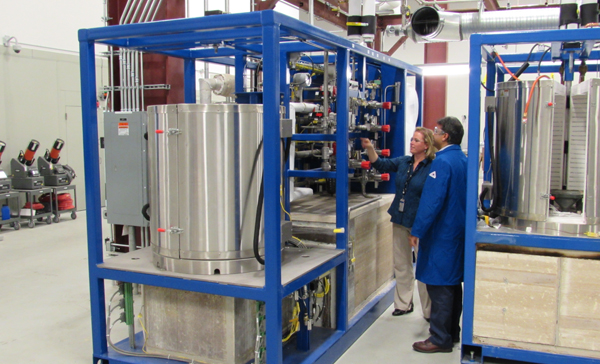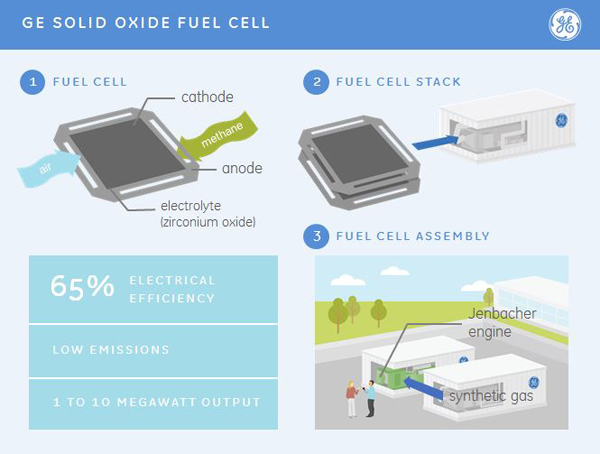
[Image above] GE Fuel Cells general manager Johanna Wellington and a team member inspect a test stand of fuel cell stacks. Credit: GE
Fuel cells are always big news around these parts.
From funding to advances in the advanced ceramic materials that provide hydrogen storage, we at CTT write about fuel cells just about as much as we write about batteries, wearables, and smartphone displays—and for good reason.
The fuel cell market is continuously changing and expanding, and those changes and expansions increasingly impact the technologies that influence how our readers and members live, work, and play.
According to the 2012 Fuel Cell Technologies Market Report from the Department of Energy, published in 2013, fuel cell shipments are on the rise—with total shipments increasing by 34 percent over 2011 figures, and 321 percent over those from 2008.
Likewise, research and development in both the public and private sectors have ramped up, with the Energy Department’s studies focused on three main areas: transportation fuel cell systems (air management, thermal and water management technologies); distributed/stationary fuel cell systems (stand-alone power plants for towns and cities, backup power); and fuel cell subsystems and components (fuel cell stack components, fuel processors for stationary applications).
Never one to rest on its laurels, GE has taken its R&D destiny into its own hands, creating an internal startup to manufacture its new fuel cell technology that can produce between 1 and 10 megawatts of power at a generation efficiency of 65 percent.
According to a GE Reports report (which quotes GE materials scientist, ACerS member, and NICE president Kristen Brosnan), the solid oxide fuel cell breakthrough spurred the start of the new facility dedicated to the manufacture and development of fuel cells. Located in upstate New York and backed by GE’s ecoimagination program, the operation could soon be providing low-cost electricity to residential energy customers.
A “game-changer,” the new technology replaces the use of expensive platinum and rare earth metals with more cost-effective stainless steel. The literal “icing” on this cake? A ceramic material triple threat that contains “cathode on top, the anode on the bottom, and a dense layer of solid oxide electrolyte in the middle.”
But the cell’s sweet structure isn’t limited to icing. “The fuel cell has no moving parts,” says the report. “The guts of the cell look like a stack of cookies. Each cookie is a metallic plate with a maze of flow channels cut into the bottom and a square of black ‘icing’ on top.”
Equally sweet is the tech’s price tag.
“The cost challenges associated with the technology have stumped a lot of people for a long time,” GE Global Research technology leader and fuel cell head Johanna Wellington says. “But we made it work, and we made it work economically.”
Using the same additive thermal spray technology that puts coatings on the company’s jet engines, the anode and electrolyte are applied, and the cathode screen-printed, on the tile.
“Our materials are easy to apply, can handle large temperature swings, and last a long time,” Brosnan says.
The fuel cell business is operating independently of GE Global Research and building its facility, which already includes the equipment needed to produce the new tech, near Saratoga Springs, N.Y.
Scientists at the SLAC National Accelerator Laboratory and Technical University of Denmark have their own alternative fuel cell offering. Click here to read about their platinum-yttrium alloy mixture that’s cheaper and more active than regular platinum catalysts.

